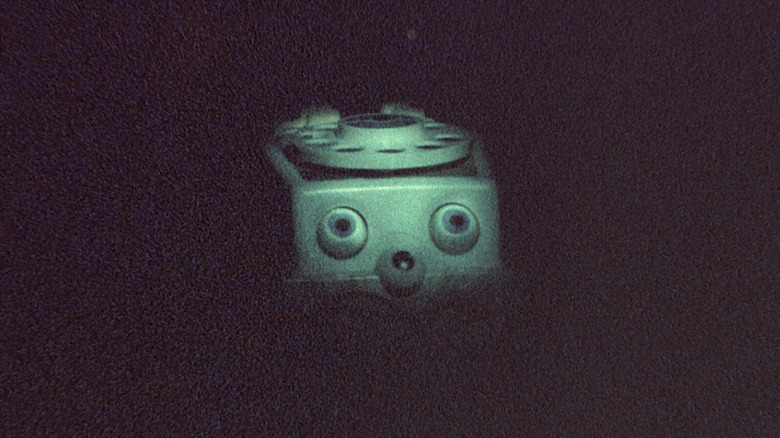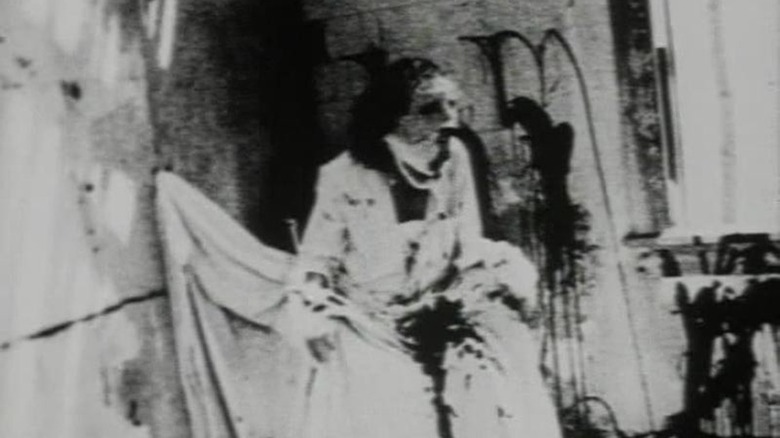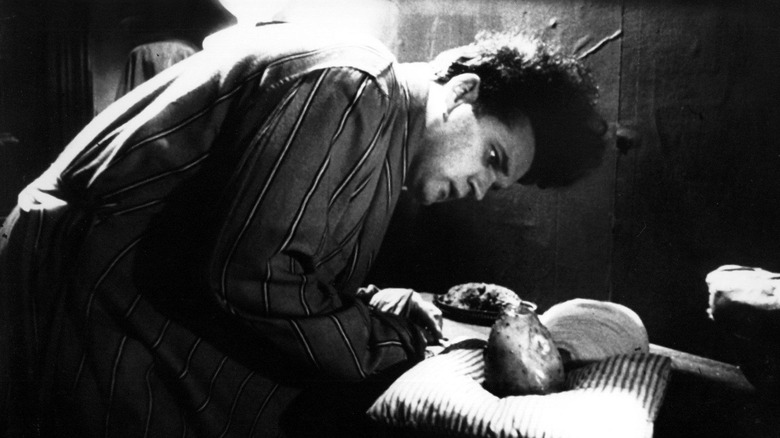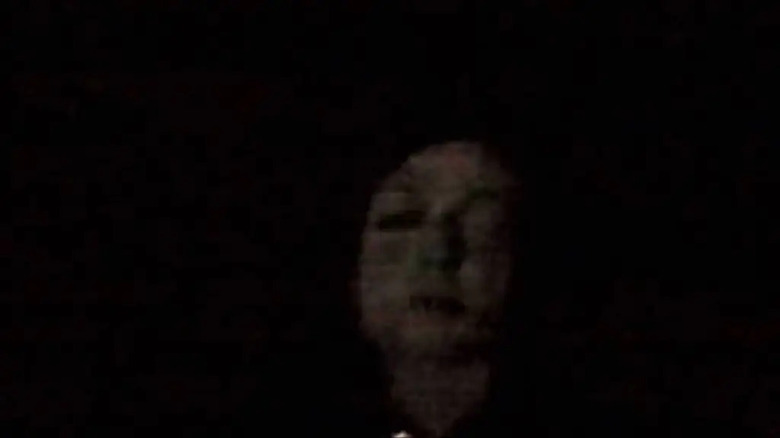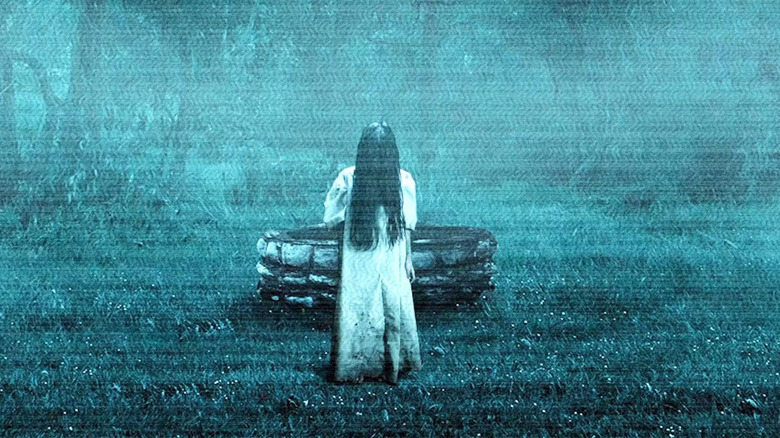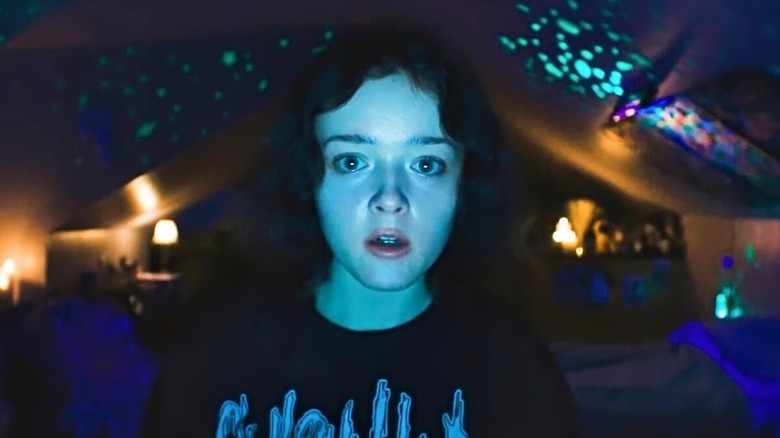5 Films To Watch If You Liked Skinamarink
"Skinamarink" is an immersive cinematic experience unlike any other. It moves at a slow pace through abstract shots of mundane domestic objects — walls, door frames, carpet — accompanied by the eerie sounds of whispering voices and creaking floors. Viewers cannot identify with the main characters, young children who wander in a dreamlike state through their home in search of their parents. An evil figure seems to follow them. You never see their faces, only the back of their heads or parts of their bodies. This cryptic filmmaking approach has left viewers speculating over several different theories as to what's really going on.
Although "Skinamarink" is a unique film, it draws influence from many other horror genre favorites. This list points to films that are similar in style or story to "Skinamarink." They have an unnerving directorial vision with terrifying images that burn into your brain long after the credits roll.
Begotten
E. Elias Merhige's "Begotten" is one of the best religious horror movies. The film appeals to those who enjoyed the experimental confusion of "Skinamarink." The stark black and white images of "Begotten" are far more granular, making it difficult to discern exactly what is going on. Supposedly, "Begotten" is about the death of God and Mother Earth giving birth to the Son of Earth who eventually dies at the hands of faceless nomads. There are no sounds to anchor you into the story, just a dead silence that immerses you in the grotesque visuals.
In the opening scene, a ghoulish figure with a fleshy mask and robes convulses in the corner with blood pouring from his mouth. The camera pushes close as he disembowels himself, feverishly slicing into his slimy and slippery organs. This is one of the many stomach-churning close-ups of sickening acts such as cannibalism and dismemberment. Like "Skinamarink," Merhige's film is a grainy, half-remembered nightmare with surreal and frightening images that you cannot look away from. But it is far more gory and nihilistic.
Eraserhead
In his piece that proclaims "Skinamarink" as the scariest horror movie of 2023, /Film writer Witney Sebold draws comparisons to David Lynch's "Eraserhead":
"Lynch's 1977 film was also notoriously slow-paced, and also seemed to take place within a nightmare. 'Eraserhead,' however, did have scenes of dialogue and incident. "Skinamarink" is a more abstract experience. It does away with the pesky constructs of plot, character, and other such useless fineries of screenwriting 101. It delivers, instead, fear unadulterated."
David Lynch is one of the greatest filmmakers that explores the world of dreams. His phantasmagorical films are an assault the senses, filled with unsettling sights and sounds that leave a lasting impression. The sharp, gothic, black-and-white visuals give the film an uncanny feeling that skewers any sense of realism. "Eraserhead" contemplates subconscious sexual anxieties in the confines of suburbia through the story of a wedlock pregnancy that turns into a strange, wailing, lizard-like creature. There is also a disfigured woman with tumor-like cheeks living inside a radiator.
Lynch also uses sound design to create an uncomfortable viewing experience. Throughout the film, there is a low and incessant industrial hum — crackles, whistles, and moans that sound like dying machines. Kyle Edward Ball plays with sound in "Skinamarink," treating the audience to several heart-jumping moments where an ear-piercing whine suddenly penetrates the silence. Both "Skinamarink" and "Eraserhead" are sensory-driven films with distinct styles.
Lake Mungo
"Skinamarink" has a subtle dread that echoes the Australian found footage horror film "Lake Mungo," which /Film writer Chris Evangelista rightfully calls one of the scariest movies ever made. Designed as a faux documentary, "Lake Mungo" follows the Palmer family wrestling with the death of their teenage daughter Alice. They believe her ghost is haunting their home, and their paranormal investigation reveals devastating secrets.
"Lake Mungo" seizes its grip on the audience through its slow, methodical scrutiny of seemingly normal situations marked by an unearthly presence. The documentary-within-the-film studies spooky images from the past and present, trying to prove the existence of spirits.
The mystical and foreboding ending takes place at Lake Mungo, a dry lake with rocky terrain where ancient remains were found. Shortly before Alice's death, she records herself saying, "I feel like something bad is going to happen to me. It hasn't reached me yet but it's on its way." What finally reaches her is a chilling image that is reminiscent of Kaylee's distorted face in "Skinamarink." In the same vein as "Skinamarink," "Lake Mungo" moves slowly with a wary uncertainty. Both films examine the harrowing fear of what is seen and unseen between this world and the next.
The Ring
The various shots of fuzzy television programs and static in "Skinamarink" bring Gore Verbinski's "The Ring" to mind. /Film describes "The Ring" as a "neverending horror story," one that has had a grip on popular culture since its 2002 release. Part of what makes "The Ring" so petrifying is the lo-fi and German Expressionist feel of the haunted VHS tape.
Both films have a vintage home video aesthetic. The montage of the cursed videotape in "The Ring" feels like the entirety of "Skinamarink": a hazy collection of childhood memories. Samara projects her vengeful emotions and tragic memories through the images on the VHS tape. We see the ring of light when she was trapped at the bottom of the well; broken nails as she tried to climb out; a sea of maggots; a mouth with intestines being pulled out of it.
The spirits in "Skinamarink" and "The Ring" manipulate the television to frighten their victims. After seven days, Samara crawls out of the television and into the real world; she claim viewer's lives if they do not share her story by passing on the tape. The malevolent presence in "Skinamarink" warps a 1930s cartoon where a dog tries to capture a rabbit who escapes by folding into himself. The scene plays over and over again, as if sending the message that it is impossible to hide from such a powerful evil.
Both films also feature searing images of distorted faces: twisted photographs of the cursed people, Samara behind her long black hair, the infamous closet scene with the dead schoolgirl, and Kaylee's face without eyes and a mouth. These disturbing visuals address the deep fear of not being able to escape the inevitable.
We're All Going to the World's Fair
"We're All Going to the World's Fair" has a similar aesthetic to "Skinamarink" and also features a small cast. "Is this a horror movie? A mystery? A thriller? There are elements of all of those things here, but the movie defies easy categorization, and its low-fi vibe and metaphor-heavy approach will not be everyone's cup of tea," Ben Pearson writes in his /Film review.
Filmed through the camera of a teenage girl's computer screen, "We're All Going to the World's Fair" is not plot-driven, but rather jumbled pieces of Casey's home videos and the videos she obsessively watches of an online role-playing horror game called World's Fair. Through the webcam-style close-ups and voyeuristic shots, director Jane Schoenbrun engulfs the audience in Casey's lonely depression and desperate search for connection through creepy stories and accounts of the supposed changes to her body.
Much like the children of "Skinamarink," Casey's isolation and mental deterioration is palpable. In one scene, she lets out a blood-curdling scream after she sings and dances alone in her room; she talks of wanting to harm herself or her father with his gun; later, Casey covers herself in green glow paint and tears apart her stuffed animal from childhood, then weeps about the damage. "We're All Going to the World's Fair" recalls "Skinamarink" in its strangeness: it is also the story of a splintered mental state where the reality of the situation is unclear.
